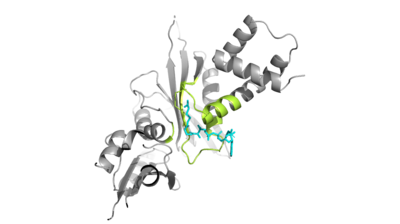TextToBeDisplayed</scene>
Histone Acetyltransferase HAT1/HAT2 Complex, Saccharomyces cerevisiae
This is a default text for your page Caitlin Marie Gaich/Sandbox1. Click above on edit this page to modify. Be careful with the < and > signs.
You may include any references to papers as in: the use of JSmol in Proteopedia [1] or to the article describing Jmol [2] to the rescue.
Introduction
Histone background
HAT1 Background
Hat1/Hat2 Complex Structure
This is a sample scene created with SAT to by Group, and another to make of the protein. You can make your own scenes on SAT starting from scratch or loading and editing one of these sample scenes.
Mechanism
Of the five classes of HAT enzymes, the catalytic mechanisms for two of those enzymes, HAT1 and Rtt109, remains unclear. A structural overlay of HAT1 and Gcn5, a more well-known and understood HAT enzyme, found a conserved glutamate residue in the active site of both molecules. It was found that mutation at that active site glutamate residue greatly alters the catalytic ability of HAT1 and has been proven to be structurally important. [3] Using this information and structural information regarding the proximity of potentially catalytic residues, the most plausible mechanism for histone acetylation involves the following relevant residues and cofactors .
In this mechanism, the glutamate at residue 255 acts as a general base and deprotonates lysine 12 of histone 4 (the numbering of the modified lysine residue on histone 4 is shifted two residues).The deprotonated lysine then acts as a nucleophile and attacks the carbonyl carbon of acetyl coenzyme A (CoA, forming a tetrahedral intermediate transition state. The negative charge on the oxygen collapses down to for a double bond and the scissle bond between the carbonyl carbon and the sulfur atom of acetyl CoA is broken. The resulting product of this reaction is histone 4 with an acetyl-lysine at residue 12 and CoEnzyme A.
Application
References
- ↑ Hanson, R. M., Prilusky, J., Renjian, Z., Nakane, T. and Sussman, J. L. (2013), JSmol and the Next-Generation Web-Based Representation of 3D Molecular Structure as Applied to Proteopedia. Isr. J. Chem., 53:207-216. doi:http://dx.doi.org/10.1002/ijch.201300024
- ↑ Herraez A. Biomolecules in the computer: Jmol to the rescue. Biochem Mol Biol Educ. 2006 Jul;34(4):255-61. doi: 10.1002/bmb.2006.494034042644. PMID:21638687 doi:10.1002/bmb.2006.494034042644
- ↑ Li Y, Zhang L, Liu T, Chai C, Fang Q, Wu H, Agudelo Garcia PA, Han Z, Zong S, Yu Y, Zhang X, Parthun MR, Chai J, Xu RM, Yang M. Hat2p recognizes the histone H3 tail to specify the acetylation of the newly synthesized H3/H4 heterodimer by the Hat1p/Hat2p complex. Genes Dev. 2014 Jun 1;28(11):1217-27. doi: 10.1101/gad.240531.114. Epub 2014 May , 16. PMID:24835250 doi:http://dx.doi.org/10.1101/gad.240531.114
Student Contributors
- Caitlin Gaich
- Jordan Finch
- Morgan Buckley

